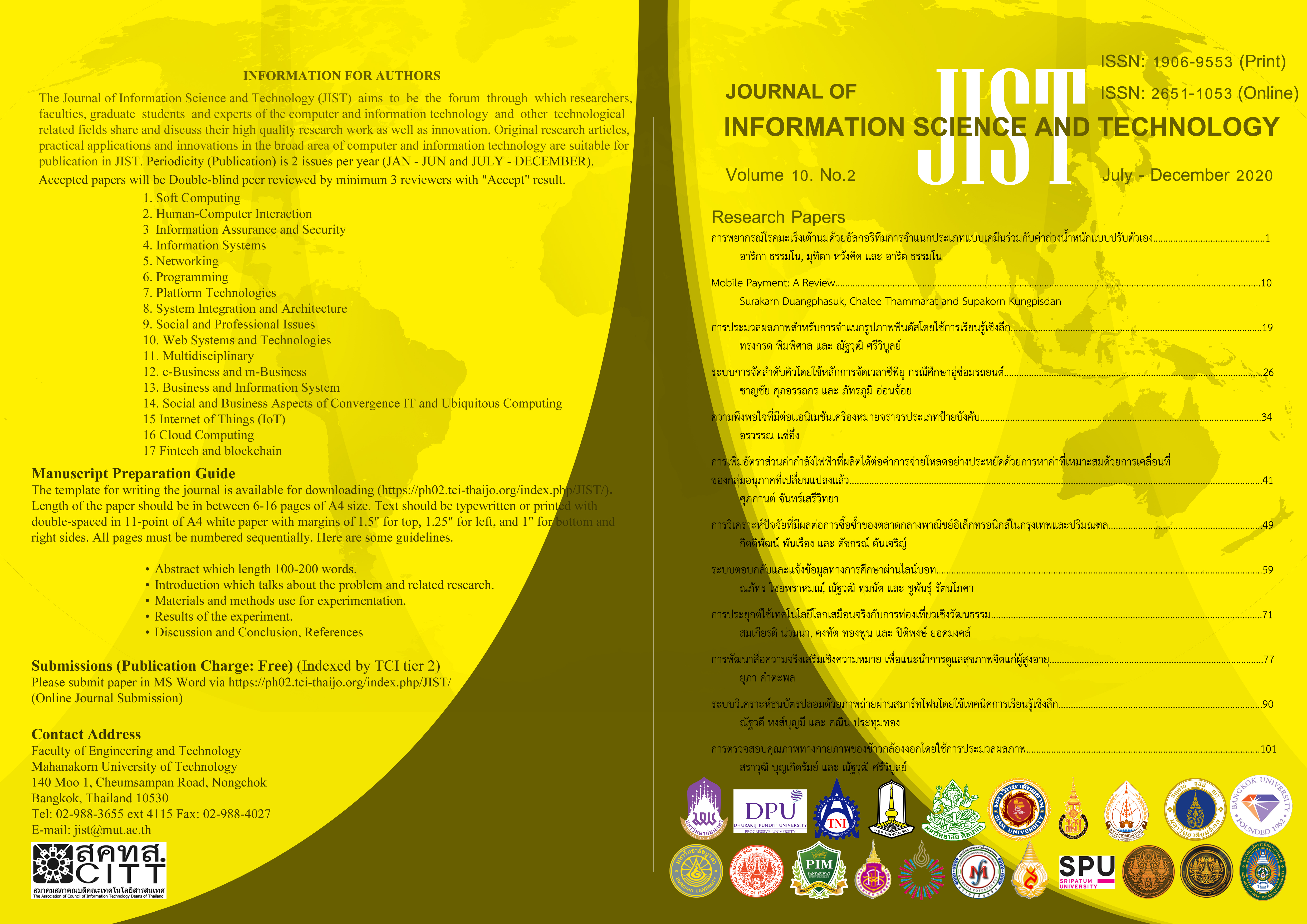การพยากรณ์โรคมะเร็งเต้านมด้วยอัลกอริทึมการจำแนกประเภทแบบเคมีน ร่วมกับค่าถ่วงน้ำหนักแบบปรับตัวเอง
Main Article Content
บทคัดย่อ
“มะเร็งเต้านม” เป็นโรคในกลุ่มโรคไม่ติดต่อเรื้อรังที่พบมากเป็นอันดับหนึ่งในผู้หญิงทั้งในประเทศไทยและต่างประเทศ สถิติของสถาบันมะเร็งแห่งชาติระบุว่า ผู้หญิงไทยที่ป่วยเป็นโรคมะเร็งเต้านมมีแนวโน้มที่จะเพิ่มมากขึ้นทุกปี ซึ่งถ้าหากตรวจพบเร็วและสามารถรักษาได้ถูกวิธี ก็จะสามารถลดอัตราความเสี่ยงในการเสียชีวิตได้อย่างมาก งานวิจัยนี้จึงได้นำเสนออัลกอริทึมการจำแนกประเภทแบบเคมีนร่วมกับค่าถ่วงน้ำหนักแบบปรับตัวเอง รวมทั้งทำการพัฒนาโปรแกรมพยากรณ์โรคมะเร็งเต้านมด้วยภาษาไพทอน โดยมีจุดประสงค์เพื่อช่วยในการคัดกรองผู้ป่วยโรคมะเร็งเต้านมในเบื้องต้น เพื่อให้กระบวนการการวินิจฉัยเป็นไปได้อย่างรวดเร็วและสามารถรักษาได้อย่างทันเวลา โดยอัลกอริทึมที่นำเสนอเป็นอัลกอริทึมที่ถูกพัฒนาต่อยอดมาจากอัลกอริทึมการแบ่งกลุ่มแบบเคมีนให้มีความสามารถในการจำแนกประเภท และปรับเปลี่ยนค่าถ่วงน้ำหนักของคุณลักษณะเด่นในสมการหาระยะห่างระหว่างข้อมูลกับจุดศูนย์กลางของประเภทแต่ละประเภทให้เหมาะสมได้ด้วยตัวเองในระหว่างการเรียนรู้ชุดข้อมูล งานวิจัยนี้ได้ทำการทดสอบประสิทธิภาพของอัลกอริทึมและโปรแกรมการพยากรณ์โรคมะเร็งเต้านมที่นำเสนอโดยใช้ชุดข้อมูล Breast Cancer Coimbra ผลการทดสอบแสดงให้เห็นถึงความถูกต้องในการพยากรณ์โรคมะเร็งเต้านมของอัลกอริทึมที่นำเสนอที่สูงกว่าอัลกอริทึมทางปัญญาประดิษฐ์อื่นๆ
Article Details
This work is licensed under a Creative Commons Attribution-NonCommercial-NoDerivatives 4.0 International License.
I/we certify that I/we have participated sufficiently in the intellectual content, conception and design of this work or the analysis and interpretation of the data (when applicable), as well as the writing of the manuscript, to take public responsibility for it and have agreed to have my/our name listed as a contributor. I/we believe the manuscript represents valid work. Neither this manuscript nor one with substantially similar content under my/our authorship has been published or is being considered for publication elsewhere, except as described in the covering letter. I/we certify that all the data collected during the study is presented in this manuscript and no data from the study has been or will be published separately. I/we attest that, if requested by the editors, I/we will provide the data/information or will cooperate fully in obtaining and providing the data/information on which the manuscript is based, for examination by the editors or their assignees. Financial interests, direct or indirect, that exist or may be perceived to exist for individual contributors in connection with the content of this paper have been disclosed in the cover letter. Sources of outside support of the project are named in the cover letter.
I/We hereby transfer(s), assign(s), or otherwise convey(s) all copyright ownership, including any and all rights incidental thereto, exclusively to the Journal, in the event that such work is published by the Journal. The Journal shall own the work, including 1) copyright; 2) the right to grant permission to republish the article in whole or in part, with or without fee; 3) the right to produce preprints or reprints and translate into languages other than English for sale or free distribution; and 4) the right to republish the work in a collection of articles in any other mechanical or electronic format.
We give the rights to the corresponding author to make necessary changes as per the request of the journal, do the rest of the correspondence on our behalf and he/she will act as the guarantor for the manuscript on our behalf.
All persons who have made substantial contributions to the work reported in the manuscript, but who are not contributors, are named in the Acknowledgment and have given me/us their written permission to be named. If I/we do not include an Acknowledgment that means I/we have not received substantial contributions from non-contributors and no contributor has been omitted.
References
National Cancer Institute, Department of Medical Services, Ministry of Public Health, Thailand, Hospital-based cancer registry. Bangkok: National Cancer Institute, 2013.
National Cancer Institute, Department of Medical Services, Ministry of Public Health, Thailand, “National Cancer Institute Strategic Plan, 2019 to 2022,” Bangkok: National Cancer Institute, 2020.
A. Ratanawichitrasin, “What is the difference between breast ultrasound and mammography,” Siriraj E-public Library, July, 2020. [Online]. Available: https://www.si.mahidol.ac.th/sidoctor/epl/articledetail.asp?id=307. [Accessed July. 10, 2020].
Khonkaen Ram Hospital, “Breast cancer screening using digital mammography,” Khonkaen Ram Hospital, July, 2020. [Online]. Available: http://www.khonkaenram.com /th/services/health-information/healtharticles/ mammogram. [Accessed July. 10, 2020].
R. Siegel, J. Ma, Z. Zou, and A. Jemal, “Cancer statistics,” CA Cancer J Clin, Vol. 64, No. 1, pp. 9-29, 2014.
Siriraj Piyamaharajkarun Hospital, “Breast cancer treatment,” Siriraj Piyamaharajkarun Hospital, July, 2020. [Online]. Available: https://www.siphhospital .com /th/news/article/share/1002/Breast-Cancer-Treatment. [Accessed July. 10, 2020].
National Cancer Institute, Department of Medical Services, Ministry of Public Health, Thailand, Hospital-based cancer registry. Bangkok: National Cancer Institute, 2010.
S. Senawong, “Types of tumor markers,” Siriraj E-public Library, July, 2020. [Online]. Available: https://www.si.mahidol.ac.th/sidoctor/e-pl/articledetail .asp?id=618. [Accessed July. 10, 2020].
S. Senawong, “Can a blood test detect cancer?,” Siriraj E-public Library, [Online]. Available: https://www.si.mahidol.ac.th/sidoctor/e-pl/articledetail .asp?id=619. [Accessed July. 10, 2020].
F. Sardouk, A. D. Duru, and O. Bayat, “Classification of breast cancer using data mining,” American Scientific Research Journal for Engineering, Technology, and Sciences, Vol. 51, No. 1, pp. 38-46, 2019.
R. Ray, A. A. Abdullah, D. K. Mallick, and S. R. Dash, “Classification of benign and malignant breast cancer using supervised machine learning algorithms based on image and numeric datasets,” Journal of Physics: Conference Series, Vol. 1372, 2019, 012062, DOI:10.1088/1742-6596/1372/1/012062, 2019.
Y. D. Austria, J. P. Lalata, L. B. Sta. Maria, Jr., J. E. E. Goh, M. L. I. Goh, H. N.Vicente, “Comparison of machine learning algorithms in breast cancer prediction using the coimbra dataset,” International Journal of Simulation: Systems, DOI: 10.5013/IJSSST.a.20.S2.23, 2019.
M. Patrício, J. Pereira, J. Crisóstomo, P. Matafome, M. Gomes, R. Seiça, and F. Caramelo, “Using resistin, glucose, age and BMI to predict the presence of breast cancer,” BMC Cancer, Vol. 18, No. 1, 2018.
D. Dua and C. Graff, UCI Machine Learning Repository [http://archive.ics.uci.edu/ml]. Irvine, CA: University of California, School of Information and Computer Science, 2019.


